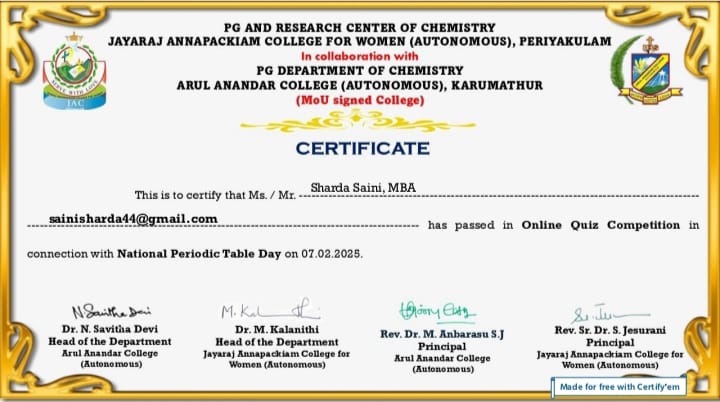
Organizer: Under the auspices of the Chemistry Association, the PG and Research Center of Chemistry at Jayaraj Annapackiam College for Women (Autonomous), in collaboration with the PG Department of Chemistry at Arul Anandar College (Autonomous), Karumathur.
About the Quiz
- Online Quiz Competition on February 7, 2025, to celebrate National Periodic Table Day.
- Free Participants
- Open to All.
- A total of 432 students from other colleges and Universities and 117 students from our college participated.
- E-certificates were awarded to those who scored 75% and above.
Apply Link
Dr. N. Savitha Devi
Head & Assistant Professor Arul Anandar College (Autonomous) Karumathur
Dr. M. Kalanithi Head & Associate Professor Jayaraj Annapackiam College for Women (Autonomous) Periyakulam
100 % Correct Answers Here
Section I: Answer all the questions
10 x 1 = 10
Which one of the following elements is not an alkaline earth metal?
*
1 point
a) Calcium
b) Radium
c) Potassium
d) Barium
This is a required question
How many naturally occurring elements are there in the periodic table?
*
1 point
a) 94
b) 88
c) 118
d) 92
The number of valence electrons of B is ——–
*
1 point
a) 5
b) 3
c) 4
d) 8
What is the maximum number of electrons that can accommodate in the k shell? *
1 point
(a) 2 electrons.
(b) 8 electrons.
(c) 18 electrons.
(d) 32 electrons.
This is a required question
What is the atomic mass of nitrogen?
*
1 point
a) 14
b) 22
c) 7
d) 28
Who is the creator of the periodic table?
*
1 point
a) Dimitri Mendeleev
b) Henry Moseley
c) Marie Curie
d) John Dalton
Who is the creator of the periodic table?
*
1 point
a) Dimitri Mendeleev
b) Henry Moseley
c) Marie Curie
d) John Dalton
This is a required question
The atomic number of tantalum is ———-*
1 point
a) 22
b) 81
c) 52
d) 73
Which one among the following has lowest electron affinity?
*
1 point
a) Fluorine
b) Argon
c) Chlorine
d) Bromine
Identify the element which has zero valency? *
1 point
(a) Chlorine
(b) Helium
(c) Caesium
(d) Livermorium
What is the atomic number for cesium?
*
1 point
a) 55
b) 20
c) 5
d) 75
Section II: True or False
5 of 5 points
5 x 1 = 5
Elements in the d-block are called inner transition elements.*
1/1
True
False
There are 18 rows in the periodic table.*
1/1
True
False
Elements in the same group have similar properties.*
1/1
True
False
Which of the following statements is incorrect?*
1/1
Elements with high electronegativity always have high electron affinity.
Electron affinity is the property of an isolated atom.
Electronegativity is the property of bonded atoms.
Both electronegativity and electron affinity are usually directly related to nuclear charge.
Carbon is a liquid at room temperature.*
1/1
True
False
Section III: Arrange in the order
5 of 5 points
5 x 1 = 5
The order of electron affinities of N, O, S and Cl are ———–*
1/1
(a) N < O < S < Cl
(b) O < N < Cl < S
(c) O < Cl < N < S
(d) O < S < Cl < N
Arrange the following elements in the order of their increasing non-metallic character Li, O, C, Be, F. *
1/1
a) 𝑭 < 𝑶 < 𝑪 < 𝑩𝒆 < 𝑳𝒊 b) 𝑳𝒊 < 𝑩𝒆 < 𝑪 < 𝑶 < 𝑭 c) 𝑭 < 𝑶 < 𝑪 < 𝑩𝒆 < 𝑳𝒊 d) 𝑨𝒍 > 𝑵𝒂 > 𝑺𝒊 > 𝑪𝒂 > 𝑴𝒈
Arrange the following elements in the order of their decreasing metallic character Na, Si, Cl, Mg, Al. *
1/1
a) 𝑪𝒍 > 𝑺𝒊 > 𝑨𝒍 > 𝑴𝒈 > 𝑵𝒂
b) 𝑵𝒂 > 𝑴𝒈 > 𝑨𝒍 > 𝑺𝒊 > 𝑪𝒍
c) 𝑵𝒂 > 𝑨𝒍 > 𝑴𝒈 > 𝑪𝒍 > 𝑺𝒊
d) 𝑨𝒍 > 𝑵𝒂 > 𝑺𝒊 > 𝑪𝒂 > 𝑴𝒈
Which of the following set of elements is written in the order of their increasing metallic character? *
1/1
a) Be, Mg, Ca
b) Na, Li, K
c) Mg, Al, Si
d) C, O, N
The correct order of electron affinity among halogens is :*
1/1
a) F > Cl > Br > I
b) Cl < F > Br > I
c) Cl > F > Br > I
d) F > Br > Cl> I
Section IV
5 of 5 points
5 x 1 = 5
Based on which property the elements are arranged in the periodic table?*
1/1
a) Atomic number
b) Atomic mass
c) Density
d) Electronegativity
Which group elements are called transition metals?*
1/1
a) Group number 1 to 2
b) Group number 13 to 18
c) Group number 3 to 12
d) Group number 1 to 8
Which group in the periodic table contains the most reactive non-metals?*
1/1
a) Group 1
b) Group 17
c) Group 18
d) Group 2
What happens to the atomic radius as you move across a period (left to right) in the periodic table?*
1/1
a) Increases
b) Decreases
c) Remains constant
Which of the following elements has the same number of valence electrons as sodium (Na)?*
1/1
a) Lithium (Li)
b) Potassium (K)
c) Magnesium (Mg)
d) Chlorine (Cl)